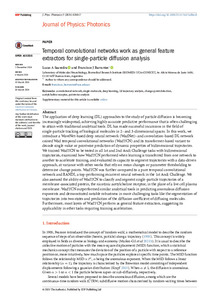Por favor, use este identificador para citar o enlazar este ítem:
https://repositorio.uca.edu.ar/handle/123456789/20082| Campo DC | Valor | Lengua/Idioma |
|---|---|---|
| dc.contributor.author | Saavedra, Lucas A. | es |
| dc.contributor.author | Barrantes, Francisco J. | es |
| dc.date.accessioned | 2025-07-10T17:38:52Z | - |
| dc.date.available | 2025-07-10T17:38:52Z | - |
| dc.date.issued | 2025 | - |
| dc.identifier.issn | 2515-7647 | - |
| dc.identifier.uri | https://repositorio.uca.edu.ar/handle/123456789/20082 | - |
| dc.description.abstract | The application of deep learning (DL) approaches to the study of particle diffusion is becoming increasingly widespread, achieving highly accurate predictive performance that is often challenging to attain with traditional analytical tools. DL has made successful incursions in the field of single-particle tracking of biological molecules in 2- and 3-dimensional spaces. In this work, we introduce a WaveNet-based deep neural network (WadNet)- and convolution-based DL network coined Wad temporal convolutional networks (WadTCN) and its transformer-based variant to decode single-value or pointwise prediction of dynamic properties of bidimensional trajectories. We trained WadTCN to be tested in all 1st and 2nd Andi Challenge tasks with bidimensional trajectories, examined how WadTCN performed when learning is transferred from one network to another to accelerate training, and evaluated its capacity to segment trajectories with a data-driven approach, at variance with other works that rely on mean changes or parameter thresholding to determine change points. WadTCN was further compared to a pure temporal convolutional network and RANDI, a top-performing recurrent neural network in the 1st Andi Challenge. We also assessed the ability of WadTCN to classify and segment single-particle trajectories of a membrane-associated protein, the nicotinic acetylcholine receptor, in the plane of a live cell plasma membrane. WadTCN outperformed similar analytical tools in predicting anomalous diffusion exponents and demonstrated notable robustness in more challenging tasks like the segmentation of trajectories into two states and prediction of the diffusion coefficient of diffusing molecules. Furthermore, most layers of WadTCN perform as general feature extractors, suggesting its applicability in other tasks requiring training acceleration. | es |
| dc.format | application/pdf | es |
| dc.language.iso | spa | es |
| dc.publisher | IOP Publishing | es |
| dc.rights | Atribución-NoComercial-CompartirIgual 4.0 Internacional | * |
| dc.rights.uri | http://creativecommons.org/licenses/by-nc-sa/4.0/ | * |
| dc.source | JPhys Photonics. 7, 2025. | es |
| dc.subject | APRENDIZAJE PROFUNDO | es |
| dc.subject | DIFUSION DE PARTICULAS | es |
| dc.subject | MODELOS DE SIMULACION | es |
| dc.title | Temporal convolutional networks work as general feature extractors for single-particle diffusion analysis | es |
| dc.type | Artículo | es |
| dc.identifier.doi | 10.1088/2515-7647/adbec8 | - |
| uca.issnrd | 0 | es |
| uca.affiliation | Fil: Saavedra, Lucas A. Pontificia Universidad Católica Argentina. Facultad de Ciencias Médicas; Argentina | es |
| uca.affiliation | Fil: Barrantes, Francisco J. Pontificia Universidad Católica Argentina. Facultad de Ciencias Médicas; Argentina | es |
| uca.version | publishedVersion | es |
| item.fulltext | With Fulltext | - |
| item.languageiso639-1 | es | - |
| item.grantfulltext | open | - |
| crisitem.author.dept | Instituto de Investigaciones Biomédicas - BIOMED | - |
| crisitem.author.dept | Laboratorio de Neurobiología Molecular | - |
| crisitem.author.dept | Facultad de Ciencias Médicas | - |
| crisitem.author.orcid | 0000-0002-4745-681X | - |
| crisitem.author.parentorg | Facultad de Ciencias Médicas | - |
| crisitem.author.parentorg | Instituto de Investigaciones Biomédicas - BIOMED | - |
| crisitem.author.parentorg | Pontificia Universidad Católica Argentina | - |
| Aparece en las colecciones: | Artículos | |
Ficheros en este ítem:
| Fichero | Descripción | Tamaño | Formato | |
|---|---|---|---|---|
| temporal-convolutional-networks.pdf | 1,63 MB | Adobe PDF |  Visualizar/Abrir |
Este ítem está sujeto a una Licencia Creative Commons

